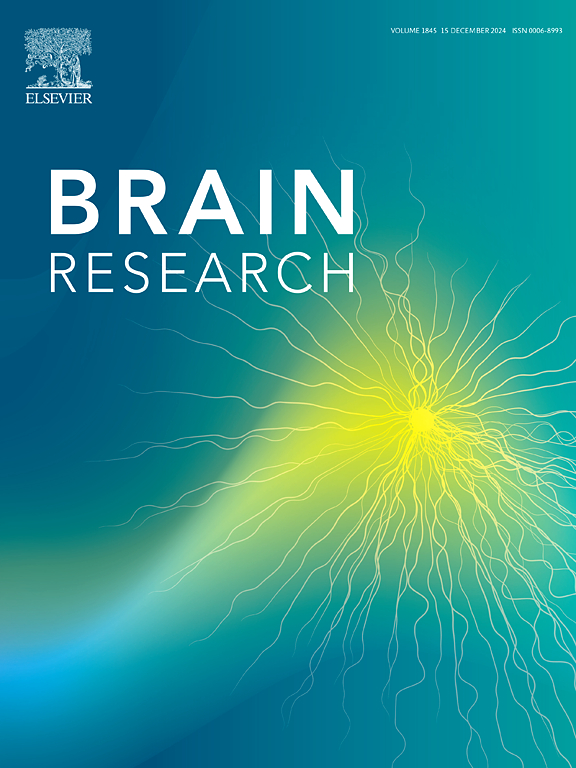Comparing levetiracetam and zonisamide effects on rivastigmine anti-Alzheimer’s activity in aluminum chloride-induced Alzheimer’s-like disease in rats: Impact on α7 nicotinic acetylcholine receptors and amyloid β
IF 2.7
4区 医学
Q3 NEUROSCIENCES
引用次数: 0
Abstract
Background and aim
Alzheimer’s disease (AD) is the most progressive form of neurodegenerative disease, which severely impairs cognitive function. The leading class of drugs used to treat AD is acetylcholinesterase inhibitors (AChE-Is) as Rivastigmine (RIVA), partially ameliorate its cognitive symptoms. Since epilepsy is a common comorbidity with AD, we explored the potential that new the antiepileptic drugs; Levetiracetam (LEV) and Zonisamide (ZNS) may possess an additional therapeutic benefit to RIVA in AlCl3-induced AD rat model.
Materials and methods
AlCl3 was used to provoke AD in rats which were then supplemented with treatment drugs for 2 weeks. Treated groups were: Control, AlCl3, RIVA, LEV, RIVA + LEV, ZNS and RIVA + ZNS. Then, the behavioral tests; passive avoidance (PA), Morris water maze (MWM) and novel object recognition (NOR) were conducted to assess cognitive behavior and memory. The Hippocampal Aβ assembly was thoroughly examined by histopathology and ELISA. α7 Nicotinic ACh receptors’ (α7nAChRs) expression was assessed immunohistochemically and by real-time quantitative polymerase chain reaction (qPCR). Caspase 3 expression was also assessed by real-time qPCR in hippocampal tissues.
Results
AlCl3 administration impaired memory and cognitive functions in rats, augmented hippocampal Aβ deposition, with subsequent neurodegeneration and α7nAChRs down-regulation. LEV, but not ZNS, administration significantly mitigated AlCl3-induced cognitive impairment probably through suppression of amyloid β (Aβ) deposition, enhancement of neurogenesis and α7nAChRs expression. When combined to RIVA, ZNS treatment negatively affected cognition possibly through its impact on hippocampal Aβ and subsequent neuronal damage.
Conclusion
Although our results indicated that neither LEV nor ZNS provided any extra benefit to cognitive enhancements in AD rats receiving rivastigmine, LEV demonstrated positive effects individually while ZNS had negative effects when combined with RIVA. As a result, this study suggests the use of LEV rather than ZNS for managing epilepsy in patients with AD given that Alzheimer’s and epilepsy can coexist.

左乙拉西坦和唑尼沙胺对氯铝诱导的大鼠阿尔茨海默病的抗阿尔茨海默活性的影响:对α7烟碱乙酰胆碱受体和β淀粉样蛋白的影响
背景和目的阿尔茨海默病(AD)是最严重的神经退行性疾病,严重损害认知功能。用于治疗AD的主要药物是乙酰胆碱酯酶抑制剂(AChE-Is),如利瓦斯汀(RIVA),部分改善其认知症状。由于癫痫是AD的常见合并症,我们探索了新的抗癫痫药物的潜力;左乙西坦(LEV)和唑尼沙胺(ZNS)在alcl3诱导的AD大鼠模型中可能对RIVA具有额外的治疗益处。材料与方法用salcl3刺激大鼠AD,然后辅以治疗药物2周。治疗组为:对照组、AlCl3、RIVA、LEV、RIVA + LEV、ZNS和RIVA + ZNS。然后是行为测试;采用被动回避(PA)、Morris水迷宫(MWM)和新物体识别(NOR)对大鼠的认知行为和记忆进行评估。采用组织病理学和酶联免疫吸附法检测海马Aβ组装。采用免疫组织化学和实时定量聚合酶链反应(qPCR)检测α7烟碱ACh受体(α7nAChRs)的表达。real-time qPCR检测海马组织中Caspase 3的表达。结果salcl3损伤了大鼠的记忆和认知功能,增加了海马Aβ沉积,导致神经变性和α7nAChRs下调。LEV(而非ZNS)可能通过抑制β淀粉样蛋白(Aβ)沉积、增强神经发生和α7nAChRs表达来显著减轻alcl3诱导的认知功能障碍。当与RIVA联合使用时,ZNS治疗可能通过对海马Aβ的影响和随后的神经元损伤而对认知产生负面影响。结论:虽然我们的研究结果表明LEV和ZNS对接受利瓦斯汀治疗的AD大鼠的认知增强没有任何额外的益处,但LEV单独显示出积极的作用,而ZNS与RIVA联合使用时显示出负面作用。因此,鉴于阿尔茨海默病和癫痫可以共存,本研究建议使用LEV而不是ZNS来治疗AD患者的癫痫。
本文章由计算机程序翻译,如有差异,请以英文原文为准。
求助全文
约1分钟内获得全文
求助全文
来源期刊

Brain Research
医学-神经科学
CiteScore
5.90
自引率
3.40%
发文量
268
审稿时长
47 days
期刊介绍:
An international multidisciplinary journal devoted to fundamental research in the brain sciences.
Brain Research publishes papers reporting interdisciplinary investigations of nervous system structure and function that are of general interest to the international community of neuroscientists. As is evident from the journals name, its scope is broad, ranging from cellular and molecular studies through systems neuroscience, cognition and disease. Invited reviews are also published; suggestions for and inquiries about potential reviews are welcomed.
With the appearance of the final issue of the 2011 subscription, Vol. 67/1-2 (24 June 2011), Brain Research Reviews has ceased publication as a distinct journal separate from Brain Research. Review articles accepted for Brain Research are now published in that journal.
 求助内容:
求助内容: 应助结果提醒方式:
应助结果提醒方式:


